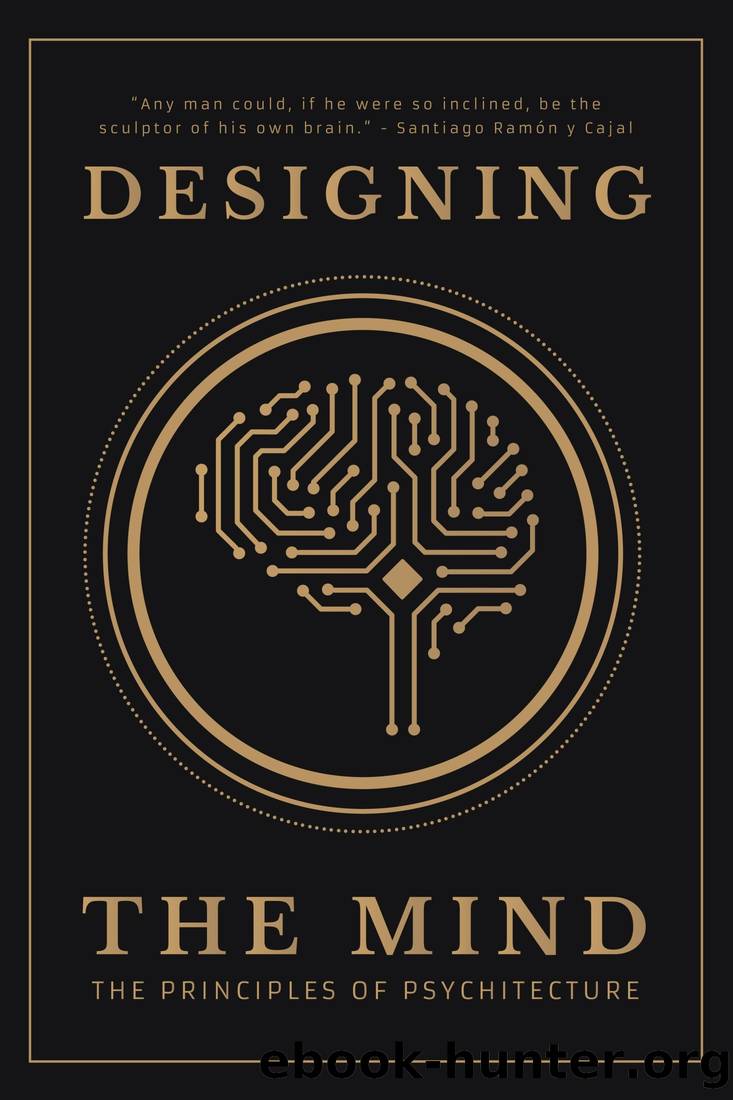Designing the Mind: The Principles of Psychitecture by Ryan A Bush Designing the Mind

Author:Ryan A Bush, Designing the Mind [Mind, Ryan A Bush, Designing the]
Language: eng
Format: epub
Tags: Psychology, Philosophy, Neuroscience, Mind, Brain, Transformation
ISBN: 9781737846208
Amazon: 1737846209
Publisher: Vibhatsu
Published: 2021-01-01T18:30:00+00:00
Key Takeaways
The other primary tool for altering our emotions is through altering our desires.
Because desires cause us pain and frustration when they are not satisfied, every desire we harbor is a potential threat to our contentment and stability.
Popular wisdomâs solution to the suffering caused by desire is to try your best to succeed at achieving your goals, and maybe you wonât suffer so much.
The alternate approach suggested by wise thinkers throughout history is to control our desires directly rather than simply trying to control our circumstances.
By learning to modulate our desires, we can not only reduce the temptations and increase the fuel propelling us toward our goals, we can eliminate a major source of suffering.
Buddhism, Epicureanism, and Stoicism all offered different but interrelated solutions to the problems caused by desire.
The psychitectâs goal is not to eliminate all desire, but to become a proficient desire manipulator - if we can tame our desires and develop agility at modulating them so we want the right things at any given time, we can leverage them to fuel us toward our goals as effectively as possible.
The first and most basic skill we must practice is the ability to up-regulate , or increase, and down-regulate , or decrease a particular desire.
To up-regulate a desire, focus purely on the desired stimulus and all of its most positive aspects and delicious details.
To down-regulate a desire, distract yourself from the desired stimulus, focus on it in a purely objective way, and cultivate a non-attached awareness of the feelings associated with the desire.
Gratitude can be used as a method for up-regulating all desires for what you already have while down-regulating desires for what you lack.
The related practice of negative visualization entails reflecting on the possibility of losing what you have, which down-regulates our desire to possess and keep something permanently and up-regulates our desire and appreciation for what we have in the present moment to inoculate ourselves against loss.
The Buddhist contemplation of nonself states that the concept of the self is entirely an illusion, which can down-regulate all identity-based desires by reminding ourselves of the flaws with the entire self-construct when circumstances clash with these desires to be liked or respected.
The view from above , which consists of contemplating the vastness of the cosmos, and the contrasting smallness of all of oneâs petty concerns, can be used to down-regulate all of your desires in bulk when you are overly invested in general.
To deal with the same job rejection from the previous chapter, you could engage in gratitude to up-regulate your desire for all the great things you have, or you could down-regulate the desire causing your suffering by reminding yourself of itâs negative qualities.
Once you learn and strengthen your ability to use these tactics, you will be able to adjust your desires at will, largely eliminating the tendency to suffer over ungratified longings.
Counteraction entails balancing out a desire by up or down-regulating an equal and opposing desire so they âcancelâ one another out.
You can become so skilled at counteraction
Download
This site does not store any files on its server. We only index and link to content provided by other sites. Please contact the content providers to delete copyright contents if any and email us, we'll remove relevant links or contents immediately.
The remains of the day by Kazuo Ishiguro(8892)
Tools of Titans by Timothy Ferriss(8304)
Giovanni's Room by James Baldwin(7251)
The Black Swan by Nassim Nicholas Taleb(7056)
Inner Engineering: A Yogi's Guide to Joy by Sadhguru(6752)
The Way of Zen by Alan W. Watts(6552)
Asking the Right Questions: A Guide to Critical Thinking by M. Neil Browne & Stuart M. Keeley(5708)
The Power of Now: A Guide to Spiritual Enlightenment by Eckhart Tolle(5679)
The Six Wives Of Henry VIII (WOMEN IN HISTORY) by Fraser Antonia(5455)
Astrophysics for People in a Hurry by Neil DeGrasse Tyson(5151)
Housekeeping by Marilynne Robinson(4392)
12 Rules for Life by Jordan B. Peterson(4276)
Double Down (Diary of a Wimpy Kid Book 11) by Jeff Kinney(4240)
The Ethical Slut by Janet W. Hardy(4212)
Skin in the Game by Nassim Nicholas Taleb(4202)
Ikigai by Héctor García & Francesc Miralles(4173)
The Art of Happiness by The Dalai Lama(4090)
Skin in the Game: Hidden Asymmetries in Daily Life by Nassim Nicholas Taleb(3961)
Walking by Henry David Thoreau(3922)
